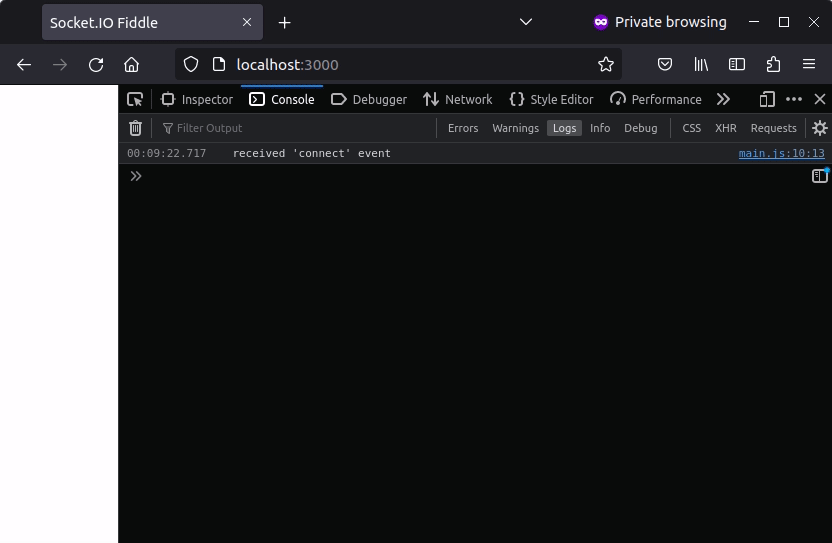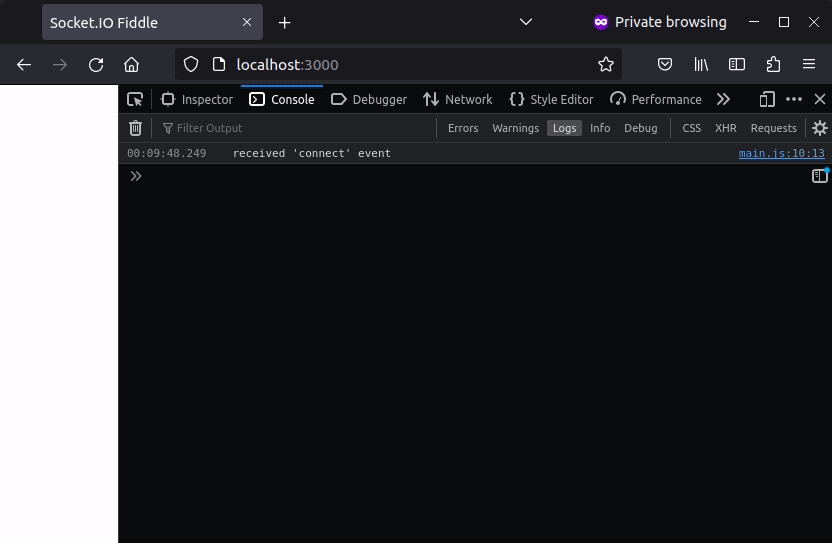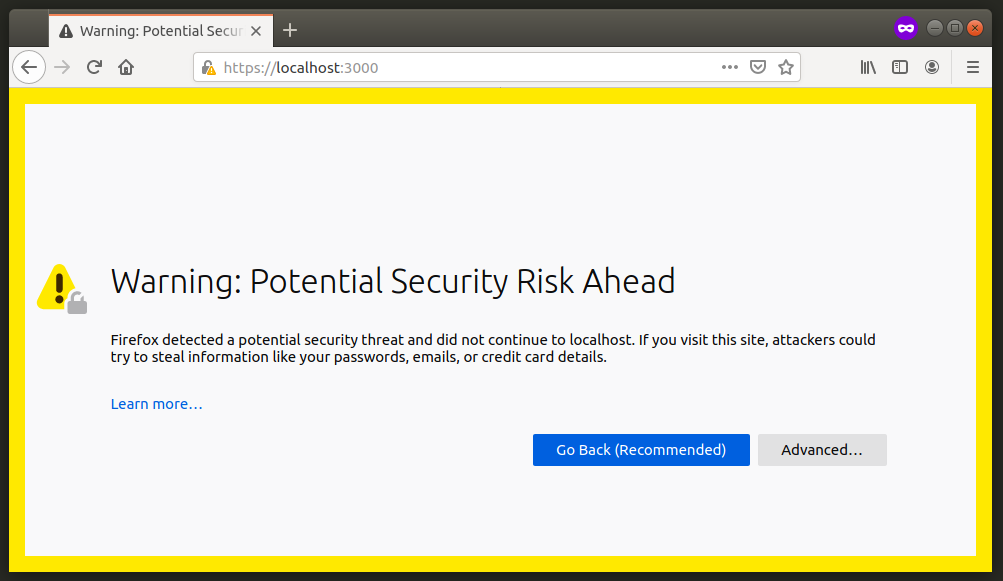Client options
IO factory options
forceNew
Default value: false
Whether to create a new Manager instance.
A Manager instance is in charge of the low-level connection to the server (established with HTTP long-polling or WebSocket). It handles the reconnection logic.
A Socket instance is the interface which is used to sends events to — and receive events from — the server. It belongs to a given namespace.
A single Manager can be attached to several Socket instances.
The following example will reuse the same Manager instance for the 3 Socket instances (one single WebSocket connection):
const socket = io("https://example.com"); // the main namespace
const productSocket = io("https://example.com/product"); // the "product" namespace
const orderSocket = io("https://example.com/order"); // the "order" namespace
The following example will create 3 different Manager instances (and thus 3 distinct WebSocket connections):
const socket = io("https://example.com"); // the main namespace
const productSocket = io("https://example.com/product", { forceNew: true }); // the "product" namespace
const orderSocket = io("https://example.com/order", { forceNew: true }); // the "order" namespace
Reusing an existing namespace will also create a new Manager each time:
const socket1 = io(); // 1st manager
const socket2 = io(); // 2nd manager
const socket3 = io("/admin"); // reuse the 1st manager
const socket4 = io("/admin"); // 3rd manager
multiplex
Default value: true
The opposite of forceNew: whether to reuse an existing Manager instance.
const socket = io(); // 1st manager
const adminSocket = io("/admin", { multiplex: false }); // 2nd manager
Low-level engine options
These settings will be shared by all Socket instances attached to the same Manager.
addTrailingSlash
Added in v4.6.0
The trailing slash which was added by default can now be disabled:
import { io } from "socket.io-client";
const socket = io("https://example.com", {
addTrailingSlash: false
});
In the example above, the request URL will be https://example.com/socket.io instead of https://example.com/socket.io/.
autoUnref
Added in v4.0.0
Default value: false
With autoUnref set to true, the Socket.IO client will allow the program to exit if there is no other active timer/TCP socket in the event system (even if the client is connected):
import { io } from "socket.io-client";
const socket = io({
autoUnref: true
});
See also: https://nodejs.org/api/timers.html#timeoutunref
closeOnBeforeunload
History
| Version | Changes |
|---|---|
| v4.7.1 | The option now defaults to false. |
| v4.1.0 | First implementation. |
Default value: false
Whether to (silently) close the connection when the beforeunload event is emitted in the browser.
When this option is set to false (the default value), the Socket instance will emit a disconnect event when the user reloads the page on Firefox:

This behavior is specific to Firefox, on other browsers the Socket instance will not emit any disconnect event when the user reloads the page.
When this option is set to true, all browsers will have the same behavior (no disconnect event when reloading the page):

If you use the beforeunload event in your application ("are you sure that you want to leave this page?"), it is recommended to leave this option to false.
Please check this issue for more information.
extraHeaders
Default value: -
Additional headers (then found in socket.handshake.headers object on the server-side).
Example:
Client
import { io } from "socket.io-client";
const socket = io({
extraHeaders: {
"my-custom-header": "1234"
}
});
Server
io.on("connection", (socket) => {
console.log(socket.handshake.headers); // an object containing "my-custom-header": "1234"
});
In a browser environment, the extraHeaders option will be ignored if you only enable the WebSocket transport, since the WebSocket API in the browser does not allow providing custom headers.
import { io } from "socket.io-client";
const socket = io({
transports: ["websocket"],
extraHeaders: {
"my-custom-header": "1234" // ignored
}
});
This will work in Node.js or in React-Native though.
Documentation: WebSocket API
forceBase64
Default value: false
Whether to force base64 encoding for binary content sent over WebSocket (always enabled for HTTP long-polling).
path
Default value: /socket.io/
It is the name of the path that is captured on the server side.
The server and the client values must match (unless you are using a path-rewriting proxy in between).
Client
import { io } from "socket.io-client";
const socket = io("https://example.com", {
path: "/my-custom-path/"
});
Server
import { createServer } from "http";
import { Server } from "socket.io";
const httpServer = createServer();
const io = new Server(httpServer, {
path: "/my-custom-path/"
});
Please note that this is different from the path in the URI, which represents the Namespace.
Example:
import { io } from "socket.io-client";
const socket = io("https://example.com/order", {
path: "/my-custom-path/"
});
- the Socket instance is attached to the "order" Namespace
- the HTTP requests will look like:
GET https://example.com/my-custom-path/?EIO=4&transport=polling&t=ML4jUwU
protocols
Added in v2.0.0
Default value: -
Either a single protocol string or an array of protocol strings. These strings are used to indicate sub-protocols, so that a single server can implement multiple WebSocket sub-protocols (for example, you might want one server to be able to handle different types of interactions depending on the specified protocol).
import { io } from "socket.io-client";
const socket = io({
transports: ["websocket"],
protocols: ["my-protocol-v1"]
});
Server:
io.on("connection", (socket) => {
const transport = socket.conn.transport;
console.log(transport.socket.protocol); // prints "my-protocol-v1"
});
References:
- https://datatracker.ietf.org/doc/html/rfc6455#section-1.9
- https://developer.mozilla.org/en-US/docs/Web/API/WebSocket/WebSocket
query
Default value: -
Additional query parameters (then found in socket.handshake.query object on the server-side).
Example:
Client
import { io } from "socket.io-client";
const socket = io({
query: {
x: 42
}
});
Server
io.on("connection", (socket) => {
console.log(socket.handshake.query); // prints { x: "42", EIO: "4", transport: "polling" }
});
The query parameters cannot be updated for the duration of the session, so changing the query on the client-side will only be effective when the current session gets closed and a new one is created:
socket.io.on("reconnect_attempt", () => {
socket.io.opts.query.x++;
});
Note: the following query parameters are reserved and can't be used in your application:
EIO: the version of the protocol (currently, "4")transport: the transport name ("polling" or "websocket")sid: the session IDj: if the transport is polling but a JSONP response is requiredt: a hashed-timestamp used for cache-busting
rememberUpgrade
Default value: false
If true and if the previous WebSocket connection to the server succeeded, the connection attempt will bypass the normal upgrade process and will initially try WebSocket. A connection attempt following a transport error will use the normal upgrade process. It is recommended you turn this on only when using SSL/TLS connections, or if you know that your network does not block websockets.
timestampParam
Default value: "t"
The name of the query parameter to use as our timestamp key.
timestampRequests
Default value: true
Whether to add the timestamp query param to each request (for cache busting).
transportOptions
Added in v2.0.0
Default value: {}
Transport-specific options.
Example:
import { io } from "socket.io-client";
const socket = io({
path: "/path-for-http-long-polling/",
transportOptions: {
websocket: {
path: "/path-for-websocket/"
}
}
});
transports
History
| Version | Changes |
|---|---|
| v4.7.0 | webtransport is added. |
| v1.0.0 | First implementation. |
Default value: ["polling", "websocket", "webtransport"]
The low-level connection to the Socket.IO server can either be established with:
- HTTP long-polling: successive HTTP requests (
POSTfor writing,GETfor reading) - WebSocket
- WebTransport
The following example disables the HTTP long-polling transport:
const socket = io("https://example.com", { transports: ["websocket"] });
Note: in that case, sticky sessions are not required on the server side (more information here).
By default, the HTTP long-polling connection is established first, and then an upgrade to WebSocket is attempted (explanation here). You can use WebSocket first with:
const socket = io("https://example.com", {
transports: ["websocket", "polling"] // use WebSocket first, if available
});
socket.on("connect_error", () => {
// revert to classic upgrade
socket.io.opts.transports = ["polling", "websocket"];
});
One possible downside is that the validity of your CORS configuration will only be checked if the WebSocket connection fails to be established.
upgrade
Default value: true
Whether the client should try to upgrade the transport from HTTP long-polling to something better.
withCredentials
History
| Version | Changes |
|---|---|
| v4.7.0 | The Node.js client now honors the withCredentials setting. |
| v3.0.0 | withCredentials now defaults to false. |
| v1.0.0 | First implementation. |
Default value: false
Whether the cross-site requests should be sent including credentials such as cookies, authorization headers or TLS client certificates. Setting withCredentials has no effect on same-site requests.
import { io } from "socket.io-client";
const socket = io("https://my-backend.com", {
withCredentials: true
});
The server needs to send the right Access-Control-Allow-* headers to allow the connection:
import { createServer } from "http";
import { Server } from "socket.io";
const httpServer = createServer();
const io = new Server(httpServer, {
cors: {
origin: "https://my-frontend.com",
credentials: true
}
});
You cannot use origin: * when setting withCredentials to true. This will trigger the following error:
Cross-Origin Request Blocked: The Same Origin Policy disallows reading the remote resource at ‘.../socket.io/?EIO=4&transport=polling&t=NvQfU77’. (Reason: Credential is not supported if the CORS header ‘Access-Control-Allow-Origin’ is ‘*’)
Documentation:
Starting with version 4.7.0, when setting the withCredentials option to true, the Node.js client will now include the cookies in the HTTP requests, making it easier to use it with cookie-based sticky sessions.
Node.js-specific options
The following options are supported:
agentpfxkeypassphrasecertcaciphersrejectUnauthorized
Please refer to the Node.js documentation:
Example with a self-signed certificate:
Client
import { readFileSync } from "fs";
import { io } from "socket.io-client";
const socket = io("https://example.com", {
ca: readFileSync("./cert.pem")
});
Server
import { readFileSync } from "fs";
import { createServer } from "https";
import { Server } from "socket.io";
const httpServer = createServer({
cert: readFileSync("./cert.pem"),
key: readFileSync("./key.pem")
});
const io = new Server(httpServer);
Example with client-certificate authentication:
Client
import { readFileSync } from "fs";
import { io } from "socket.io-client";
const socket = io("https://example.com", {
ca: readFileSync("./server-cert.pem"),
cert: readFileSync("./client-cert.pem"),
key: readFileSync("./client-key.pem"),
});
Server
import { readFileSync } from "fs";
import { createServer } from "https";
import { Server } from "socket.io";
const httpServer = createServer({
cert: readFileSync("./server-cert.pem"),
key: readFileSync("./server-key.pem"),
requestCert: true,
ca: [
readFileSync("client-cert.pem")
]
});
const io = new Server(httpServer);
rejectUnauthorized is a Node.js-only option, it will not bypass the security check in the browser:

Manager options
These settings will be shared by all Socket instances attached to the same Manager.
autoConnect
Default value: true
Whether to automatically connect upon creation. If set to false, you need to manually connect:
import { io } from "socket.io-client";
const socket = io({
autoConnect: false
});
socket.connect();
// or
socket.io.open();
parser
Added in v2.2.0
Default value: require("socket.io-parser")
The parser used to marshall/unmarshall packets. Please see here for more information.
randomizationFactor
Default value: 0.5
The randomization factor used when reconnecting (so that the clients do not reconnect at the exact same time after a server crash, for example).
Example with the default values:
- 1st reconnection attempt happens between 500 and 1500 ms (
1000 * 2^0 * (<something between -0.5 and 1.5>)) - 2nd reconnection attempt happens between 1000 and 3000 ms (
1000 * 2^1 * (<something between -0.5 and 1.5>)) - 3rd reconnection attempt happens between 2000 and 5000 ms (
1000 * 2^2 * (<something between -0.5 and 1.5>)) - next reconnection attempts happen after 5000 ms
reconnection
Default value: true
Whether reconnection is enabled or not. If set to false, you need to manually reconnect:
import { io } from "socket.io-client";
const socket = io({
reconnection: false
});
const tryReconnect = () => {
setTimeout(() => {
socket.io.open((err) => {
if (err) {
tryReconnect();
}
});
}, 2000);
}
socket.io.on("close", tryReconnect);
reconnectionAttempts
Default value: Infinity
The number of reconnection attempts before giving up.
reconnectionDelay
Default value: 1000
The initial delay before reconnection in milliseconds (affected by the randomizationFactor value).
reconnectionDelayMax
Default value: 5000
The maximum delay between two reconnection attempts. Each attempt increases the reconnection delay by 2x.
timeout
Default value: 20000
The timeout in milliseconds for each connection attempt.
Socket options
These settings are specific to the given Socket instance.
ackTimeout
Added in v4.6.0
Default value: -
The default timeout in milliseconds used when waiting for an acknowledgement (not to be mixed up with the already existing timeout option, which is used by the Manager during the connection)
auth
Added in v3.0.0
Default value: -
Credentials that are sent when accessing a namespace (see also here).
Example:
Client
import { io } from "socket.io-client";
const socket = io({
auth: {
token: "abcd"
}
});
// or with a function
const socket = io({
auth: (cb) => {
cb({ token: localStorage.token })
}
});
Server
io.on("connection", (socket) => {
console.log(socket.handshake.auth); // prints { token: "abcd" }
});
You can update the auth map when the access to the Namespace is denied:
socket.on("connect_error", (err) => {
if (err.message === "invalid credentials") {
socket.auth.token = "efgh";
socket.connect();
}
});
Or manually force the Socket instance to reconnect:
socket.auth.token = "efgh";
socket.disconnect().connect();
retries
Added in v4.6.0
Default value: -
The maximum number of retries. Above the limit, the packet will be discarded.
const socket = io({
retries: 3,
ackTimeout: 10000
});
// implicit ack
socket.emit("my-event");
// explicit ack
socket.emit("my-event", (err, val) => { /* ... */ });
// custom timeout (in that case the ackTimeout is optional)
socket.timeout(5000).emit("my-event", (err, val) => { /* ... */ });